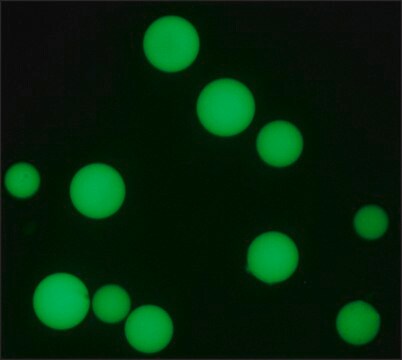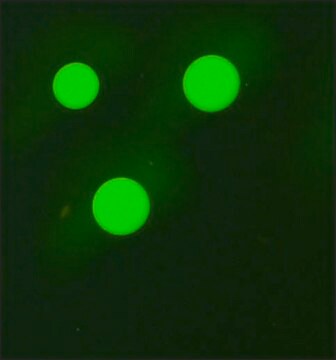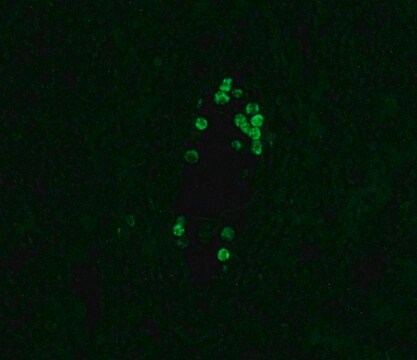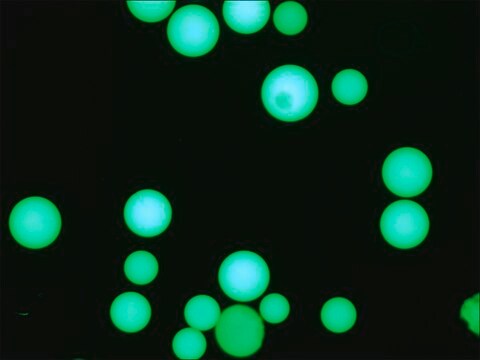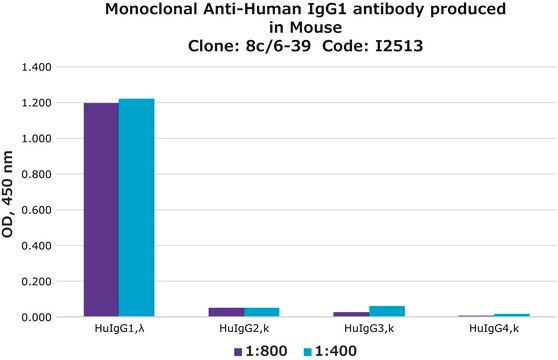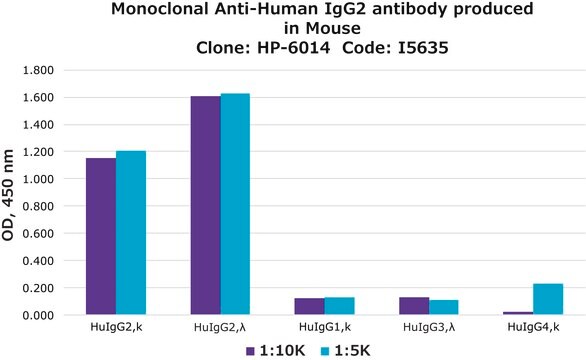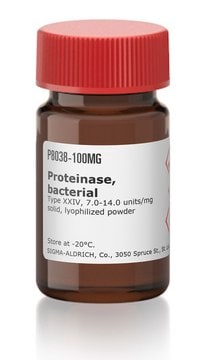F4516
Anti-Human IgG2−FITC antibody, Mouse monoclonal
clone HP-6014, purified from hybridoma cell culture
Synonym(s):
Monoclonal Anti-Human IgG2
Sign Into View Organizational & Contract Pricing
All Photos(1)
About This Item
UNSPSC Code:
12352203
NACRES:
NA.46
Recommended Products
biological source
mouse
Quality Level
conjugate
FITC conjugate
antibody form
purified from hybridoma cell culture
antibody product type
secondary antibodies
clone
HP-6014, monoclonal
form
buffered aqueous solution
storage condition
protect from light
technique(s)
dot immunobinding: 1:32
particle immunofluorescence: 1:16
isotype
IgG1
shipped in
dry ice
storage temp.
−20°C
target post-translational modification
unmodified
Looking for similar products? Visit Product Comparison Guide
General description
Immunoglobulin G (IgG) belongs to the immunoglobulin family and is a widely expressed serum antibody. It consists of a γ heavy chain in the constant (C) region. The monomeric 150kDa structure of IgG constitutes two identical heavy chains and two identical light chains with molecular weight of 50kDa and 25kDa, respectively. The primary structure of this antibody also contains disulfide bonds involved in linking the two heavy chains, linking the heavy and light chains and residues inside the chains. IgG is further subdivided into four classes namely, IgG1, IgG2, IgG3, and IgG4 with different heavy chains, named γ1, γ2, γ3, and γ4, respectively. Limited digestion using papain cleaves the antibody into three fragments, two of which are identical and contain the antigen-binding activity. They are known as fragment antigen binding (Fab) fragments. These fragments contain light chains paired with the VH and CH1 domains of the heavy chains.
Specificity
The antibody is specific for human IgG2 and is non-reactive with other IgG subclasses. This clone has been singled out as the most widely applicable IgG2 specific monoclonal antibody by the IUIS/WHO study.
Application
Monoclonal Anti-Human IgG2-FITC antibody produced in mouse has been used in immunohistochemistry.
Physical form
Solution in 0.01 M phosphate buffered saline, pH8, containing 1% inactivated bovine serum albumin and 15 mM sodium azide.
Storage and Stability
For continuous use, store at 2-8ºC for a maximum of one month. For extended storage, the solution may be frozen in working aliquots. Repeated freezing and thawing is not recommended. Storage in "frost-free" freezers is not recommended. If slight turbidity occurs upon prolonged storage, clarify by centrifugation before use.
Disclaimer
Unless otherwise stated in our catalog or other company documentation accompanying the product(s), our products are intended for research use only and are not to be used for any other purpose, which includes but is not limited to, unauthorized commercial uses, in vitro diagnostic uses, ex vivo or in vivo therapeutic uses or any type of consumption or application to humans or animals.
Not finding the right product?
Try our Product Selector Tool.
Storage Class Code
10 - Combustible liquids
WGK
WGK 3
Flash Point(F)
Not applicable
Flash Point(C)
Not applicable
Personal Protective Equipment
dust mask type N95 (US), Eyeshields, Gloves
Choose from one of the most recent versions:
Already Own This Product?
Find documentation for the products that you have recently purchased in the Document Library.
Customers Also Viewed
Antibody structure, instability, and formulation.
Wang W, et al.
Journal of Pharmaceutical Sciences (2007)
Human placental Fc receptors and the transmission of antibodies from mother to fetus.
Simister NE and Story CM
Journal of Reproductive Immunology, 37(1) (1997)
Immunobiology (2001)
Evidence for antibody-mediated pathogenesis in anti-NMDAR
encephalitis associated with ovarian teratoma
encephalitis associated with ovarian teratoma
Erdem Tuzun, et al.
Acta Neuropathologica, 118(6) (2009)
Elion Hoxha et al.
Nephrology, dialysis, transplantation : official publication of the European Dialysis and Transplant Association - European Renal Association, 26(8), 2526-2532 (2011-06-03)
The recent finding that phospholipase-A(2)-receptor antibodies (PLA(2)R-AB) may play a role in the development of primary membranous glomerulonephritis (MGN) offers the opportunity to measure a marker to help diagnose, classify and eventually monitor the course of patients with MGN. We
Our team of scientists has experience in all areas of research including Life Science, Material Science, Chemical Synthesis, Chromatography, Analytical and many others.
Contact Technical Service